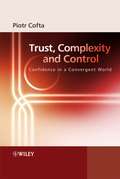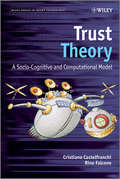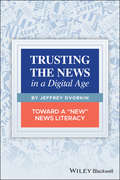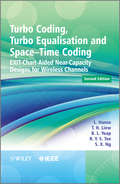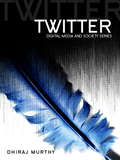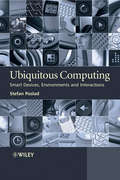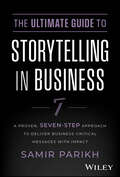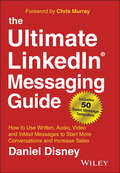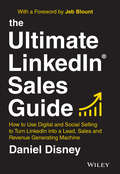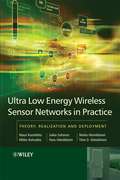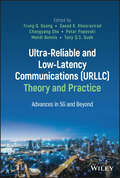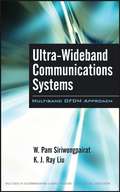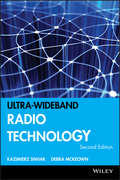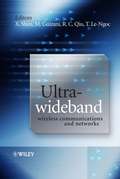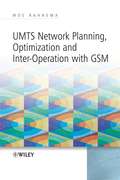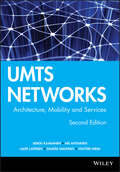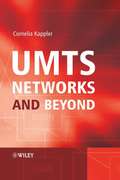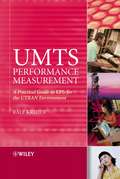- Table View
- List View
Trust, Complexity and Control: Confidence in a Convergent World
by Piotr CoftaAn increasing reliance on the Internet and mobile communication has deprived us of our usual means of assessing another party’s trustworthiness. This is increasingly forcing us to rely on control. Yet the notion of trust and trustworthiness is essential to the continued development of a technology-enabled society. Trust, Complexity and Control offers readers a single, consistent explanation of how the sociological concept of ‘trust’ can be applied to a broad spectrum of technology-related areas; convergent communication, automated agents, digital security, semantic web, artificial intelligence, e-commerce, e-government, privacy etc. It presents a model of confidence in which trust and control are driven and limited by complexity in one explanatory framework and demonstrates how that framework can be applied to different research and application areas. Starting with the individual’s assessment of trust, the book shows the reader how application of the framework can clarify misunderstandings and offer solutions to complex problems. The uniqueness of Trust, Complexity and Control is its interdisciplinary treatment of a variety of diverse areas using a single framework. Sections featured include: Trust and distrust in the digital world. The impact of convergent communication and networks on trust. Trust, economy and commerce. Trust-enhancing technologies. Trust, Complexity and Control is an invaluable source of reference for both researchers and practitioners within the Trust community. It will also be of benefit to students and lecturers in the fields of information technology, social sciences and computer engineering.
Trust Theory: A Socio-Cognitive and Computational Model (Wiley Series in Agent Technology #18)
by Christiano Castelfranchi Rino FalconeThis book provides an introduction, discussion, and formal-based modelling of trust theory and its applications in agent-based systems This book gives an accessible explanation of the importance of trust in human interaction and, in general, in autonomous cognitive agents including autonomous technologies. The authors explain the concepts of trust, and describe a principled, general theory of trust grounded on cognitive, cultural, institutional, technical, and normative solutions. This provides a strong base for the author’s discussion of role of trust in agent-based systems supporting human-computer interaction and distributed and virtual organizations or markets (multi-agent systems). Key Features: Provides an accessible introduction to trust, and its importance and applications in agent-based systems Proposes a principled, general theory of trust grounding on cognitive, cultural, institutional, technical, and normative solutions. Offers a clear, intuitive approach, and systematic integration of relevant issues Explains the dynamics of trust, and the relationship between trust and security Offers operational definitions and models directly applicable both in technical and experimental domains Includes a critical examination of trust models in economics, philosophy, psychology, sociology, and AI This book will be a valuable reference for researchers and advanced students focused on information and communication technologies (computer science, artificial intelligence, organizational sciences, and knowledge management etc.), as well as Web-site and robotics designers, and for scholars working on human, social, and cultural aspects of technology. Professionals of ecommerce systems and peer-to-peer systems will also find this text of interest.
Trusting the News in a Digital Age: Toward a "New" News Literacy
by Jeffrey DvorkinHow to use critical thinking to discern real news from fake news Trusting the News in a Digital Age provides an ethical framework and the much-need tools for assessing information produced in our digital age. With the tsunami of information on social media and other venues, many have come to distrust all forms of communication including the news. This practical text offers guidance on how to use critical thinking, appropriate skepticism, and journalistic curiosity to handle this flow of undifferentiated information. Designed to encourage critical thinking, each chapter introduces specific content, followed at the end of each section with an ethical dilemma. The ideas presented are based on the author’s experiences as a teacher and public editor/ombudsman at NPR News. Trusting the News in a Digital Age prepares readers to deal with changes to news and information in the digital environment. It brings to light the fact that journalism is about treating the public as citizens first, and consumers of information second. This important text: Reveals how to use critical thinking to handle the never-ending flow of information Contains ethical dilemmas to help sharpen critical thinking skills Explains how to verify sources and spot frauds Looks at the economic and technological conditions that facilitated changes in communication Written for students of journalism and media studies, Trusting the News in the Digital Age offers guidance on how to hone critical thinking skills needed to discern fact from fiction.
Trusting the News in a Digital Age: Toward a "New" News Literacy
by Jeffrey DvorkinTRUSTING THE NEWS in a Digital Age How to use critical thinking to discern real news from fake newsTrusting the News in a Digital Age provides an ethical framework and the much-needed tools for assessing information produced in our digital age. With the tsunami of information on social media and other venues, many have come to distrust all forms of communication, including the news. This practical text offers guidance on how to use critical thinking, appropriate skepticism, and journalistic curiosity to handle this flow of undifferentiated information.Designed to encourage critical thinking, each chapter introduces specific content, followed at the end of each section with an ethical dilemma. The ideas presented are based on the author’s experiences as a teacher and public editor/ombudsman at NPR News. Trusting the News in a Digital Age prepares readers to deal with changes to news and information in the digital environment. It brings to light the fact that journalism is about treating the public as citizens first, and consumers of information second. This important text:Reveals how to use critical thinking to handle the never-ending flow of informationContains ethical dilemmas to help sharpen critical thinking skillsExplains how to verify sources and spot fraudsLooks at the economic and technological conditions that facilitated changes in communicationWritten for students of journalism and media studies, Trusting the News in the Digital Age offers guidance on how to hone critical thinking skills needed to discern fact from fiction.
Turbo Coding, Turbo Equalisation and Space-Time Coding: EXIT-Chart-Aided Near-Capacity Designs for Wireless Channels (Wiley - IEEE #22)
by Lajos Hanzo T. H. Liew B. L. Yeap R. Y. Tee Soon Xin NgCovering the full range of channel codes from the most conventional through to the most advanced, the second edition of Turbo Coding, Turbo Equalisation and Space-Time Coding is a self-contained reference on channel coding for wireless channels. The book commences with a historical perspective on the topic, which leads to two basic component codes, convolutional and block codes. It then moves on to turbo codes which exploit iterative decoding by using algorithms, such as the Maximum-A-Posteriori (MAP), Log-MAP and Soft Output Viterbi Algorithm (SOVA), comparing their performance. It also compares Trellis Coded Modulation (TCM), Turbo Trellis Coded Modulation (TTCM), Bit-Interleaved Coded Modulation (BICM) and Iterative BICM (BICM-ID) under various channel conditions. The horizon of the content is then extended to incorporate topics which have found their way into diverse standard systems. These include space-time block and trellis codes, as well as other Multiple-Input Multiple-Output (MIMO) schemes and near-instantaneously Adaptive Quadrature Amplitude Modulation (AQAM). The book also elaborates on turbo equalisation by providing a detailed portrayal of recent advances in partial response modulation schemes using diverse channel codes. A radically new aspect for this second edition is the discussion of multi-level coding and sphere-packing schemes, Extrinsic Information Transfer (EXIT) charts, as well as an introduction to the family of Generalized Low Density Parity Check codes. This new edition includes recent advances in near-capacity turbo-transceivers as well as new sections on multi-level coding schemes and of Generalized Low Density Parity Check codes Comparatively studies diverse channel coded and turbo detected systems to give all-inclusive information for researchers, engineers and students Details EXIT-chart based irregular transceiver designs Uses rich performance comparisons as well as diverse near-capacity design examples
Turbo Coding, Turbo Equalisation and Space-Time Coding: EXIT-Chart-Aided Near-Capacity Designs for Wireless Channels (Wiley - IEEE #21)
by Lajos Hanzo T. H. Liew B. L. Yeap R. Y. Tee Soon Xin NgCovering the full range of channel codes from the most conventional through to the most advanced, the second edition of Turbo Coding, Turbo Equalisation and Space-Time Coding is a self-contained reference on channel coding for wireless channels. The book commences with a historical perspective on the topic, which leads to two basic component codes, convolutional and block codes. It then moves on to turbo codes which exploit iterative decoding by using algorithms, such as the Maximum-A-Posteriori (MAP), Log-MAP and Soft Output Viterbi Algorithm (SOVA), comparing their performance. It also compares Trellis Coded Modulation (TCM), Turbo Trellis Coded Modulation (TTCM), Bit-Interleaved Coded Modulation (BICM) and Iterative BICM (BICM-ID) under various channel conditions. The horizon of the content is then extended to incorporate topics which have found their way into diverse standard systems. These include space-time block and trellis codes, as well as other Multiple-Input Multiple-Output (MIMO) schemes and near-instantaneously Adaptive Quadrature Amplitude Modulation (AQAM). The book also elaborates on turbo equalisation by providing a detailed portrayal of recent advances in partial response modulation schemes using diverse channel codes. A radically new aspect for this second edition is the discussion of multi-level coding and sphere-packing schemes, Extrinsic Information Transfer (EXIT) charts, as well as an introduction to the family of Generalized Low Density Parity Check codes. This new edition includes recent advances in near-capacity turbo-transceivers as well as new sections on multi-level coding schemes and of Generalized Low Density Parity Check codes Comparatively studies diverse channel coded and turbo detected systems to give all-inclusive information for researchers, engineers and students Details EXIT-chart based irregular transceiver designs Uses rich performance comparisons as well as diverse near-capacity design examples
Twitter: Social Communication in the Twitter Age (Digital Media and Society #6)
by Dhiraj MurthyTwitter has become a household name, discussed both for its role in prominent national elections, natural disasters, and political movements, as well as for what some malign as narcissistic “chatter.” This book takes a critical step back from popular discourse and media coverage of Twitter, to present the first balanced, scholarly engagement of this popular medium. In this timely and comprehensive introduction, Murthy not only discusses Twitter’s role in our political, economic, and social lives, but also draws a historical line between the telegraph and Twitter to reflect on changes in social communication over time. The book thoughtfully examines Twitter as an emergent global communications medium and provides a theoretical framework for students, scholars, and tweeters to reflect critically on the impact of Twitter and the contemporary media environment. The book uses case studies including citizen journalism, health, and national disasters to provide empirically rich insights and to help decipher some of the ways in which Twitter and social media more broadly may be shaping contemporary life.
Ubiquitous Computing: Smart Devices, Environments and Interactions
by Stefan PosladThis book provides an introduction to the complex field of ubiquitous computing Ubiquitous Computing (also commonly referred to as Pervasive Computing) describes the ways in which current technological models, based upon three base designs: smart (mobile, wireless, service) devices, smart environments (of embedded system devices) and smart interaction (between devices), relate to and support a computing vision for a greater range of computer devices, used in a greater range of (human, ICT and physical) environments and activities. The author details the rich potential of ubiquitous computing, the challenges involved in making it a reality, and the prerequisite technological infrastructure. Additionally, the book discusses the application and convergence of several current major and future computing trends. Key Features: Provides an introduction to the complex field of ubiquitous computing Describes how current technology models based upon six different technology form factors which have varying degrees of mobility wireless connectivity and service volatility: tabs, pads, boards, dust, skins and clay, enable the vision of ubiquitous computing Describes and explores how the three core designs (smart devices, environments and interaction) based upon current technology models can be applied to, and can evolve to, support a vision of ubiquitous computing and computing for the future Covers the principles of the following current technology models, including mobile wireless networks, service-oriented computing, human computer interaction, artificial intelligence, context-awareness, autonomous systems, micro-electromechanical systems, sensors, embedded controllers and robots Covers a range of interactions, between two or more UbiCom devices, between devices and people (HCI), between devices and the physical world. Includes an accompanying website with PowerPoint slides, problems and solutions, exercises, bibliography and further reading Graduate students in computer science, electrical engineering and telecommunications courses will find this a fascinating and useful introduction to the subject. It will also be of interest to ICT professionals, software and network developers and others interested in future trends and models of computing and interaction over the next decades.
Ubiquitous Computing: Smart Devices, Environments and Interactions
by Stefan PosladThis book provides an introduction to the complex field of ubiquitous computing Ubiquitous Computing (also commonly referred to as Pervasive Computing) describes the ways in which current technological models, based upon three base designs: smart (mobile, wireless, service) devices, smart environments (of embedded system devices) and smart interaction (between devices), relate to and support a computing vision for a greater range of computer devices, used in a greater range of (human, ICT and physical) environments and activities. The author details the rich potential of ubiquitous computing, the challenges involved in making it a reality, and the prerequisite technological infrastructure. Additionally, the book discusses the application and convergence of several current major and future computing trends. Key Features: Provides an introduction to the complex field of ubiquitous computing Describes how current technology models based upon six different technology form factors which have varying degrees of mobility wireless connectivity and service volatility: tabs, pads, boards, dust, skins and clay, enable the vision of ubiquitous computing Describes and explores how the three core designs (smart devices, environments and interaction) based upon current technology models can be applied to, and can evolve to, support a vision of ubiquitous computing and computing for the future Covers the principles of the following current technology models, including mobile wireless networks, service-oriented computing, human computer interaction, artificial intelligence, context-awareness, autonomous systems, micro-electromechanical systems, sensors, embedded controllers and robots Covers a range of interactions, between two or more UbiCom devices, between devices and people (HCI), between devices and the physical world. Includes an accompanying website with PowerPoint slides, problems and solutions, exercises, bibliography and further reading Graduate students in computer science, electrical engineering and telecommunications courses will find this a fascinating and useful introduction to the subject. It will also be of interest to ICT professionals, software and network developers and others interested in future trends and models of computing and interaction over the next decades.
The Ultimate Guide to Storytelling in Business: A Proven, Seven-Step Approach To Deliver Business-Critical Messages With Impact
by Samir ParikhA one-stop shop for everything that you need to know about storytelling in business. How often have you had to deliver a pitch, convey a message or empower an audience with only one chance to get it right? Perhaps a job interview, an important sales presentation, or the announcement of major changes within your organization? Have you ever had a powerful idea that was never adopted because your peers didn’t recognize its value? Storytelling is mission-critical to the advancement of our careers and our businesses. In the book, you’ll learn how to create compelling presentations, write persuasive reports, and convey important messages in meetings with stories that capture the attention of your audiences. The author explains how to convey complex ideas with simplicity, win the acceptance of others, speed up decision-making, and demonstrate your contributions as a thought leader. You’ll discover: A proven methodology, based on seven steps, enabling you to build and deliver stories in a structured, reliable and repeatable way. The importance of creating a one-page story blueprint to road-test your story. How the subtle use of emotional triggers will help you to control the reactions of your audience. A rich library of industry examples, from multi-million dollar sales opportunities to strategic change initiatives, the introduction of new business models and the launch of ground-breaking technical ideas. A 23-point checklist to ensure that you are ready for your next storytelling endeavor. Perfect for managers, directors, executives, as well as early career professionals, The Ultimate Guide to Storytelling in Business is a can’t-miss resource for generating impact and getting your ideas recognized.
The Ultimate Guide to Storytelling in Business: A Proven, Seven-Step Approach To Deliver Business-Critical Messages With Impact
by Samir ParikhA one-stop shop for everything that you need to know about storytelling in business. How often have you had to deliver a pitch, convey a message or empower an audience with only one chance to get it right? Perhaps a job interview, an important sales presentation, or the announcement of major changes within your organization? Have you ever had a powerful idea that was never adopted because your peers didn’t recognize its value? Storytelling is mission-critical to the advancement of our careers and our businesses. In the book, you’ll learn how to create compelling presentations, write persuasive reports, and convey important messages in meetings with stories that capture the attention of your audiences. The author explains how to convey complex ideas with simplicity, win the acceptance of others, speed up decision-making, and demonstrate your contributions as a thought leader. You’ll discover: A proven methodology, based on seven steps, enabling you to build and deliver stories in a structured, reliable and repeatable way. The importance of creating a one-page story blueprint to road-test your story. How the subtle use of emotional triggers will help you to control the reactions of your audience. A rich library of industry examples, from multi-million dollar sales opportunities to strategic change initiatives, the introduction of new business models and the launch of ground-breaking technical ideas. A 23-point checklist to ensure that you are ready for your next storytelling endeavor. Perfect for managers, directors, executives, as well as early career professionals, The Ultimate Guide to Storytelling in Business is a can’t-miss resource for generating impact and getting your ideas recognized.
The Ultimate LinkedIn Messaging Guide: How to Use Written, Audio, Video and InMail Messages to Start More Conversations and Increase Sales
by Daniel DisneyGet people to read, listen to, and watch your LinkedIn messages The Ultimate LinkedIn Messaging Guide is for salespeople, businesses, recruiters, and LinkedIn users who struggle to get replies and results on the essential business platform. In this book, author Daniel Disney shows you just how powerful LinkedIn can be when you figure out how to do it right. You’ll discover how to use LinkedIn messages to get noticed by employers, get attention to your business, and close deals. When you master LinkedIn messaging with the proven tips inside this book, you’ll be able to start more conversations, create more opportunities and drive more sales and revenue. What you’re looking for is out there – if you know how to reach the people who can help. But in this age of information overload, no one will respond to a spammy message, call, or e-mail. You need to stand out and prove that you’re legitimate. In this book, you’ll find real examples of successful messages, as well as over 50 message templates and scripts for written, audio, video and InMail messages. There are also QR codes throughout the book that take you to recorded examples of video and audio messages so you can see and hear them in action. Learn how to send personalised connection requests and LinkedIn messages that prompt people to talk to you Discover tips for building your network and reaching the decision makers at any company Leverage the power of audio and video messages to connect more effectively on LinkedIn Follow up and convert replies into sales, job offers, and high-value relationshipsIf you’ve struggled to get noticed, meet the right people, and close deals, The Ultimate LinkedIn Messaging Guide is the tool you need to turn it around.
The Ultimate LinkedIn Messaging Guide: How to Use Written, Audio, Video and InMail Messages to Start More Conversations and Increase Sales
by Daniel DisneyGet people to read, listen to, and watch your LinkedIn messages The Ultimate LinkedIn Messaging Guide is for salespeople, businesses, recruiters, and LinkedIn users who struggle to get replies and results on the essential business platform. In this book, author Daniel Disney shows you just how powerful LinkedIn can be when you figure out how to do it right. You’ll discover how to use LinkedIn messages to get noticed by employers, get attention to your business, and close deals. When you master LinkedIn messaging with the proven tips inside this book, you’ll be able to start more conversations, create more opportunities and drive more sales and revenue. What you’re looking for is out there – if you know how to reach the people who can help. But in this age of information overload, no one will respond to a spammy message, call, or e-mail. You need to stand out and prove that you’re legitimate. In this book, you’ll find real examples of successful messages, as well as over 50 message templates and scripts for written, audio, video and InMail messages. There are also QR codes throughout the book that take you to recorded examples of video and audio messages so you can see and hear them in action. Learn how to send personalised connection requests and LinkedIn messages that prompt people to talk to you Discover tips for building your network and reaching the decision makers at any company Leverage the power of audio and video messages to connect more effectively on LinkedIn Follow up and convert replies into sales, job offers, and high-value relationshipsIf you’ve struggled to get noticed, meet the right people, and close deals, The Ultimate LinkedIn Messaging Guide is the tool you need to turn it around.
The Ultimate LinkedIn Sales Guide: How to Use Digital and Social Selling to Turn LinkedIn into a Lead, Sales and Revenue Generating Machine
by Daniel DisneyBecome a LinkedIn power user and harness the potential of social selling With the impact of COVID, remote working has become big, and so has the use of digital/virtual sales tools. More sales teams want and need to understand how to use social media platforms like LinkedIn to sell, and most do not use it properly. The Ultimate LinkedIn Sales Guide is the go-to book and guide for utilizing LinkedIn to sell. It covers all aspects of social and digital selling, including building the ultimate LinkedIn profile, using the searching functions to find customers, sending effective LinkedIn messages (written, audio & video), creating great content that generates sales, and all the latest tips and tricks, strategies and tools. With the right LinkedIn knowledge, you can attract customers and generate leads, improving your sales numbers from the comfort and safety of your computer. No matter what you are selling, LinkedIn can connect you to buyers. If you’re savvy, you can stay in touch with clients and generate more repeat sales, build trust, and create engaging content that will spread by word-of-mouth—the most powerful sales strategy around. This book will teach you how to do all that and more. In The Ultimate LinkedIn Sales Guide you will learn how to: Use the proven 4 Pillars of Social Selling Success to improve your existing LinkedIn activities or get started on a firm footing Create the Ultimate LinkedIn Profile, complete with a strong personal brand that could catapult you to industry leader status Generate leads using LinkedIn, then build and manage relationships with connected accounts to turn those leads into customers Utilize little-known LinkedIn “power tools” to grow your network, send effective messages, and write successful LinkedIn articles And so much more! The Ultimate LinkedIn Sales Guide is a must read for anyone wishing to utilise LinkedIn to improve sales.
The Ultimate LinkedIn Sales Guide: How to Use Digital and Social Selling to Turn LinkedIn into a Lead, Sales and Revenue Generating Machine
by Daniel DisneyBecome a LinkedIn power user and harness the potential of social selling With the impact of COVID, remote working has become big, and so has the use of digital/virtual sales tools. More sales teams want and need to understand how to use social media platforms like LinkedIn to sell, and most do not use it properly. The Ultimate LinkedIn Sales Guide is the go-to book and guide for utilizing LinkedIn to sell. It covers all aspects of social and digital selling, including building the ultimate LinkedIn profile, using the searching functions to find customers, sending effective LinkedIn messages (written, audio & video), creating great content that generates sales, and all the latest tips and tricks, strategies and tools. With the right LinkedIn knowledge, you can attract customers and generate leads, improving your sales numbers from the comfort and safety of your computer. No matter what you are selling, LinkedIn can connect you to buyers. If you’re savvy, you can stay in touch with clients and generate more repeat sales, build trust, and create engaging content that will spread by word-of-mouth—the most powerful sales strategy around. This book will teach you how to do all that and more. In The Ultimate LinkedIn Sales Guide you will learn how to: Use the proven 4 Pillars of Social Selling Success to improve your existing LinkedIn activities or get started on a firm footing Create the Ultimate LinkedIn Profile, complete with a strong personal brand that could catapult you to industry leader status Generate leads using LinkedIn, then build and manage relationships with connected accounts to turn those leads into customers Utilize little-known LinkedIn “power tools” to grow your network, send effective messages, and write successful LinkedIn articles And so much more! The Ultimate LinkedIn Sales Guide is a must read for anyone wishing to utilise LinkedIn to improve sales.
Ultra-Low Energy Wireless Sensor Networks in Practice: Theory, Realization and Deployment
by Mauri Kuorilehto Mikko Kohvakka Jukka Suhonen Panu Hämäläinen Marko Hännikäinen Timo D. HamalainenFinally a book on Wireless Sensor Networks that covers real world applications and contains practical advice! Kuorilehto et al. have written the first practical guide to wireless sensor networks. The authors draw on their experience in the development and field-testing of autonomous wireless sensor networks (WSNs) to offer a comprehensive reference on fundamentals, practical matters, limitations and solutions of this fast moving research area. Ultra Low Energy Wireless Sensor Networks in Practice: Explains the essential problems and issues in real wireless sensor networks, and analyzes the most promising solutions. Provides a comprehensive guide to applications, functionality, protocols, and algorithms for WSNs. Offers practical experiences from new applications and their field-testing, including several deployed networks. Includes simulations and physical measurements for energy consumption, bit rate, latency, memory, and lifetime. Covers embedded resource-limited operating systems, middleware and application software. Ultra Low Energy Wireless Sensor Networks in Practice will prove essential reading for Research Scientists, advanced students in Networking, Electrical Engineering and Computer Science as well as Product Managers and Design Engineers.
Ultra-Reliable and Low-Latency Communications (URLLC) Theory and Practice: Advances in 5G and Beyond
by Trung Q. Duong Saeed R. Khosravirad Changyang She Petar Popovski Mehdi Bennis Tony Q. S. QuekUltra-Reliable and Low-Latency Communications (URLLC) Theory and Practice Comprehensive resource presenting important recent advances in wireless communications for URLLC services, including device-to-device communication, multi-connectivity, and more Ultra-Reliable and Low-Latency Communications (URLLC) Theory and Practice discusses the typical scenarios, possible solutions, and state-of-the-art techniques that enable URLLC in different perspectives from the physical layer to higher-level approaches, aiming to tackle URLLC’s challenges with both theoretical and practical approaches, which bridges the lacuna between theory and practice. With long-term contributions to the development of future wireless networks, the text systematically presents a thorough study of the novel and innovative paradigm of URLLC; basic requirements are covered, along with essential definitions, state-of-the-art technologies, and promising research directions of URLLC. To aid in reader comprehension, tables, figures, design schematics, and examples are provided to illustrate abstract engineering concepts and make the text more accessible to a broader readership, and corresponding case studies are included in the last part of the book. Fundamental problems in URLLC, including designing building blocks for URLLC, radio resource management in URLLC, resource optimization, network availability guarantee, and coexisting with other future mobile networks, are also discussed. In Ultra-Reliable and Low-Latency Communications (URLLC) Theory and Practice, readers can expect to find detailed information on: BCH and analog codes, stable matching, OFDM demodulation and turbo coding, and semi-blind receivers for URLLC MIMO-NOMA with URLLC, PHY and MAC layer technologies for URLLC, and Network slicing or SDN for URLLC and eMBB Integrating theoretical knowledge into deep learning for URLLC, Energy-Latency tradeoff in URLLC, and Downlink transmission for URLLC under physical layer aspects Resource allocation for multi-user downlink URLLC, HARQ optimization for 5G URLLC, and Multi-Access edge computing with URLLC A unique resource with comprehensive yet accessible coverage of a complicated subject, Ultra-Reliable and Low-Latency Communications (URLLC) Theory and Practice is an ideal resource for a large and diverse population of researchers and practitioners in engineering, computer scientists, and senior undergraduate and graduate students in related programs of study.
Ultra-Reliable and Low-Latency Communications (URLLC) Theory and Practice: Advances in 5G and Beyond
by Trung Q. Duong Saeed R. Khosravirad Changyang She Petar Popovski Mehdi Bennis Tony Q.S. QuekUltra-Reliable and Low-Latency Communications (URLLC) Theory and Practice Comprehensive resource presenting important recent advances in wireless communications for URLLC services, including device-to-device communication, multi-connectivity, and more Ultra-Reliable and Low-Latency Communications (URLLC) Theory and Practice discusses the typical scenarios, possible solutions, and state-of-the-art techniques that enable URLLC in different perspectives from the physical layer to higher-level approaches, aiming to tackle URLLC’s challenges with both theoretical and practical approaches, which bridges the lacuna between theory and practice. With long-term contributions to the development of future wireless networks, the text systematically presents a thorough study of the novel and innovative paradigm of URLLC; basic requirements are covered, along with essential definitions, state-of-the-art technologies, and promising research directions of URLLC. To aid in reader comprehension, tables, figures, design schematics, and examples are provided to illustrate abstract engineering concepts and make the text more accessible to a broader readership, and corresponding case studies are included in the last part of the book. Fundamental problems in URLLC, including designing building blocks for URLLC, radio resource management in URLLC, resource optimization, network availability guarantee, and coexisting with other future mobile networks, are also discussed. In Ultra-Reliable and Low-Latency Communications (URLLC) Theory and Practice, readers can expect to find detailed information on: BCH and analog codes, stable matching, OFDM demodulation and turbo coding, and semi-blind receivers for URLLC MIMO-NOMA with URLLC, PHY and MAC layer technologies for URLLC, and Network slicing or SDN for URLLC and eMBB Integrating theoretical knowledge into deep learning for URLLC, Energy-Latency tradeoff in URLLC, and Downlink transmission for URLLC under physical layer aspects Resource allocation for multi-user downlink URLLC, HARQ optimization for 5G URLLC, and Multi-Access edge computing with URLLC A unique resource with comprehensive yet accessible coverage of a complicated subject, Ultra-Reliable and Low-Latency Communications (URLLC) Theory and Practice is an ideal resource for a large and diverse population of researchers and practitioners in engineering, computer scientists, and senior undergraduate and graduate students in related programs of study.
Ultra-Wideband Communications Systems: Multiband OFDM Approach (Wiley - IEEE)
by W. Pam Siriwongpairat K. J. LiuThe only book that provides full coverage of UWB multiband OFDM technology Ultra-wideband (UWB) has emerged as a technology that offers great promise to satisfy the growing demand for low-cost, high-speed digital networks. The enormous bandwidth available, the potential for high data rates, and the promise for small size and low processing power with reduced implementation cost all present a unique opportunity for UWB to become a widely adopted radio solution for future wireless home networking technology. Ultra-Wideband Communications Systems is the first book to provide comprehensive coverage of the fundamental and advanced issues related to UWB technology, with a particular focus on multiband orthogonal frequency division multiplexing (multiband OFDM). The multiband OFDM approach was a leading method in the IEEE 802.15.3astandard and has recently been standardized by ECMA International. The book also explores several major advanced state-of-the-art technologies to enhance the performance of the standardized multiband OFDM approach. Additional coverage includes: * Characteristics of UWB channels * An overview of UWB single-band and multiband OFDM approaches * MIMO multiband OFDM * Performance characterization * Performance under practical considerations * Differential multiband OFDM * Power-controlled channel allocation * Cooperative UWB multiband OFDM Complete with pointers for future research opportunities to enhance the performance of UWB multiband OFDM technology over current and future wireless networks, this is an indispensable resource for graduate students, engineers, and academic and industrial researchers involved with UWB.
Ultra-wideband Radio Technology
by Kazimierz Siwiak Debra McKeownUltra-wideband (UWB) has been among the most controversial technologies of modern times. Its applications seem endless, its capabilities miraculous and yet it is so poorly understood. In this volume, the authors combine talents to de-mystify ultra-wideband radio and explain it in language that is accessible to non-technologists as well as technologists. They contrast UWB with conventional radio technology so that fundamental, technically accurate information devoid of specific technical and analytical details is accessible for marketing managers, business developers, engineering managers, technology managers, potential investors, financial analysts, executive recruiters, technical writers, and technologists from other fields. The authors also include enough specific technical and engineering information about UWB, for the seasoned technologists, engineers, scientists and academicians who need to understand the topic at an entry level. Provides simple high level, conceptual discussions of UWB followed with more detailed, scientific, mathematical, engineering focused explanations Presents a global perspective by tracing UWB throughout the history of radio, providing a modern basis for the re-emergence of the technology and for the current regulatory and standards activities Features insights into the reasons why the technology developed the way it did Explains the key advantages of UWB, including its bandwidth, potential simplicity and huge system capacity Discusses the applications of UWB in terms of the unique properties and advantages of UWB Ultra-wideband Radio Technology will inform, educate and inspire!...
Ultra-Wideband Wireless Communications and Networks
by Xuemin Shen Mohsen Guizani Robert Caiming Qiu Tho Le-NgocLearn about Ultra-wideband (UWB) transmission - the most talked about application in wireless communications. UWB wireless communication is a revolutionary technology for transmitting large amounts of digital data over a wide spectrum of frequency bands with very low power for a short distance. This exciting new text covers the fundamental aspects of UWB wireless communications systems for short-range communications. It also focuses on more advanced information about networks and applications. Chapters include: Radio Propagation and Large Scale Variations, Pulse Propagation and Channel Modelling, MIMO (Multiple Input, Multiple Output) RF Subsystems and Ad Hoc Networks. Focuses on UWB wireless communications rather than UWB radar, which has been covered before. Provides long and short-term academic and technological value. Teaches readers the fundamentals, challenges and up-to-date technical processes in this field.
UMTS Network Planning, Optimization, and Inter-Operation with GSM (Wiley - IEEE)
by Moe RahnemaUMTS Network Planning, Optimization, and Inter-Operation with GSM is an accessible, one-stop reference to help engineers effectively reduce the time and costs involved in UMTS deployment and optimization. Rahnema includes detailed coverage from both a theoretical and practical perspective on the planning and optimization aspects of UMTS, and a number of other new techniques to help operators get the most out of their networks. Provides an end-to-end perspective, from network design to optimization Incorporates the hands-on experiences of numerous researchers Single authorship allows for strong coherency and accessibility Details the complete iteration cycle of radio link budgeting for coverage planning and dimensioning Rahnema demonstrates detailed formulation of radio capacity and coverage in UMTS, and discusses the tradeoffs involved. He presents complete link budgeting and iterative simulations for capacity and coverage planning, along with practical guidelines. UMTS Network Planning contains seventeen cohesive and well-organized chapters which cover numerous topics, including: Radio channel structures, radio channel models, parameters, model tuning Techniques for capacity and coverage enhancements Complete treatment of power control, handoffs and radio resource practical management processes and parameters Detailed coverage of TCP protocol enhancement for operation over wireless links, particularly UMTS Application of GSM measurements to plan and re-engineer for UMTS radio sites Guidelines for site co-location with GSM, the QOS classes, parameters and inter-workings in UMTS AMR voice codecs and tradeoffs, core and access network design, architectural evolution, and protocols Comprehensive discussion and presentation of practical techniques for radio performance analysis, trending, and troubleshooting Perfect for professionals in the field and researchers specializing in network enhancement. Engineers working on other air interfaces and next generation technologies will find many of the techniques introduced helpful in designing and deploying future wireless networks as well. Students and professionals new to the wireless field will also find this book to be a good foundation in network planning, performance analysis, and optimization.
UMTS Networks: Architecture, Mobility and Services
by Heikki Kaaranen Ari Ahtiainen Lauri Laitinen Siamäk Naghian Valtteri NiemiBuilding on the success of the first edition, UMTS Networks second edition allows readers to continue their journey through UMTS up to the latest 3GPP standardization phase, Release 5. Containing revised, updated and brand new material, it provides a comprehensive view on the UMTS network architecture and its latest developments. Accompanied by numerous illustrations, the practical approach of the book benefits from the authors’ pioneering research and training in this field. Provides a broad yet detailed overview of the latest worldwide developments in UMTS technology. Includes brand new sections on the IP Multimedia Subsystem and High Speed Downlink Packet Access according to 3GPP Release 5 specifications. Contains heavily revised sections on the evolution from GSM to UMTS Multi-access, the UMTS Radio Access Network, the UMTS Core Network and services. Includes updated versions on services in the UMTS environment, security in the UMTS environment and UMTS protocols. Illustrates all points with cutting-edge practical examples gleaned from the authors’ research and training at the forefront of UMTS. The illustrative, hands-on approach will appeal to operators, equipment vendors, systems designers, developers and marketing professionals who require comprehensive, practical information on the latest developments in UMTS. This second edition will also benefit students and researchers in the field of mobile networking.
UMTS Networks and Beyond
by Cornelia KapplerAn all-encompassing coverage on UMTS Networks including an in-depth discussion of current work on UMTS evolution and 4G . UMTS Networks and Beyond offers a comprehensive introduction to the networking aspects of UMTS and the networks coming after UMTS. The book is unique in that it systematically compares how a particular problem, e.g. obtaining connectivity, is solved in UMTS and how the same problem is solved in a Computer Network such as the Internet. It also highlights why the respective solutions are so different. The first part of the book provides a detailed technical discussion of UMTS, including original vision, architecture, protocol stacks and overall functionality. It places UMTS in the context of its evolution of from GSM and its convergence with Computer Networks. The second part of the book discusses today’s vision of 4G, and introduces upcoming networking technologies. Emphasis is on LTE / SAE as successor of UMTS; UMB, WiMAX and NGN are also discussed. The book gives an overview of what these technologies are likely to offer, of their architectures, protocols and functionality. It also discusses their differences and similarities, and whether they will qualify as 4G. Key Features: Provides readers, particularly those with a background in IP-based networks, with a technical understanding of what UMTS does, how it works and how it is likely to evolve Explains the differences in design between UMTS Networks and Computer Networks and discusses how these design divergences can be reconciled in the future Shows how economic considerations shape the design of UMTS Motivates why particular design choices are made in UMTS Gives an in-depth introduction to LTE / SAE Provides a detailed picture of the state of the art in 4G Illustrates the theory with numerous tables and figures This comprehensive textbook is essential reading for advanced students and lecturers in communications systems and networking. It is also of interest to engineers and researchers in the field of UMTS and communications systems.
UMTS Performance Measurement: A Practical Guide to KPIs for the UTRAN Environment
by Ralf KreherUMTS Performance Measurement is a practical guide that explains how to identify and measure the main problems seen in today's UMTS live networks and will make performance measurement results gathered in the UTRAN environment understandable for the reader. It provides a fundamental background for daily work in the field or lab, covering a wide range of performance measurements that help to troubleshoot and optimize the UTRAN environment. The content goes far beyond what has been defined by international standard bodies like 3GPP and closes the gap between international standards and definitions of network equipment manufacturers (NEM) and network operators. The emphasis is on definition of Key Performance Indicators (KPIs) and measurements that are not described in 3GPP standard documents, such as throughput measurements and the success/failure analysis of all possible handover types. Includes clear coverage of the fundamentals of performance measurement software architecture and ways to collect and present statistical data Contains numerous call flow diagrams, conversion tables, protocol message examples and sample measurement results that can be used as reference for daily work in the field or lab Explains measurement limitations and how tolerances provide valuable information for validation and evaluation of measurement results Provides an overview of how performance measurement software works as well as information on how data streams are captured and analyzed, and how analysis results are aggregated and presented in graphic user interfaces and reports Providing a gateway into the world of UMTS-specific measurement scenarios and a general overview of what can be defined and measured at an in-depth technical level, this book will appeal to those involved in network operation, planning, configuration and deployment, as well as consulting and training companies, students, technical journalists and measurement equipment manufacturers.
